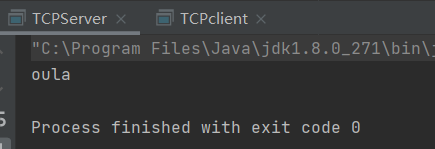分别实现client和server, 完成消息传递功能
(简易版本, 作为学习记录
client端
import java.io.IOException;
import java.io.OutputStream;
import java.net.InetAddress;
import java.net.Socket;
import java.net.UnknownHostException;
import java.nio.charset.StandardCharsets;
public class TCPclient {
public static void main(String[] args) {
int port = 9999;
Socket socket = null;
OutputStream outputStream = null;
try {
InetAddress inetAddress = InetAddress.getByName("127.0.0.1");
socket = new Socket(inetAddress, port);
outputStream = socket.getOutputStream();
outputStream.write("oula".getBytes());
} catch (UnknownHostException e) {
e.printStackTrace();
} catch (IOException e) {
e.printStackTrace();
} finally {
if (socket != null){
try {
socket.close();
} catch (IOException e) {
e.printStackTrace();
}
}
if(outputStream != null){
try {
outputStream.close();
} catch (IOException e) {
e.printStackTrace();
}
}
}
}
}
解释:
- socket作为链接通道打开指定IP和端口, 需要与服务器端一致
- 作为socket类包含输出流方法, 用outputstream承接输出流,
- OutputStream输出字符串的字符流形式到服务端
server端
import java.io.ByteArrayOutputStream;
import java.io.IOException;
import java.io.InputStream;
import java.net.ServerSocket;
import java.net.Socket;
public class TCPServer {
public static void main(String[] args) {
int port = 9999;
ServerSocket serverSocket = null;
Socket socket = null;
InputStream inputStream = null;
ByteArrayOutputStream baos = null;
try {
serverSocket = new ServerSocket(port);
socket = serverSocket.accept();
inputStream = socket.getInputStream();
baos = new ByteArrayOutputStream();
byte[] buffer = new byte[1024];
int len;
while((len = inputStream.read(buffer)) != -1){
baos.write(buffer, 0, len);
}
System.out.println(baos.toString());
} catch (IOException e) {
e.printStackTrace();
} finally {
if (serverSocket != null){
try {
serverSocket.close();
} catch (IOException e) {
e.printStackTrace();
}
}
if (socket != null){
try {
socket.close();
} catch (IOException e) {
e.printStackTrace();
}
}
if (inputStream != null){
try {
inputStream.close();
} catch (IOException e) {
e.printStackTrace();
}
}
if (baos != null){
try {
baos.close();
} catch (IOException e) {
e.printStackTrace();
}
}
}
}
}
解释
- 设置serversocket, 指定打开port端口
- 用accept方法阻塞接收客户端端口的连接请求
- inputstream承接socket的输入流
- 因为接收的是字节流, 用ByteArrayOutputStream接收输入进来的字节流(相当于存放输入进来的数据的一个变量)
- 打印的时候转toString
效果

服务端接收到并打印了"欧拉"
如果想要按输入的字符串作为传递消息, 该如何实现?
做一些修改即可
client端
import java.io.IOException;
import java.io.OutputStream;
import java.net.InetAddress;
import java.net.Socket;
import java.net.UnknownHostException;
import java.nio.charset.StandardCharsets;
import java.util.Scanner;
public class TCPclient {
public static void main(String[] args) {
int port = 9999;
Socket socket = null;
OutputStream outputStream = null;
try {
InetAddress inetAddress = InetAddress.getByName("127.0.0.1");
Scanner scanner = new Scanner(System.in);
System.out.println("input quit to exit");
while(true){
socket = new Socket(inetAddress, port);
outputStream = socket.getOutputStream();
String message = scanner.next();
if(message.equals("quit")) break;
else{
outputStream.write(message.getBytes());
socket.close();
outputStream.close();
}
}
} catch (UnknownHostException e) {
e.printStackTrace();
} catch (IOException e) {
e.printStackTrace();
} finally {
if (socket != null){
try {
socket.close();
} catch (IOException e) {
e.printStackTrace();
}
}
if(outputStream != null){
try {
outputStream.close();
} catch (IOException e) {
e.printStackTrace();
}
}
}
}
}
server端
import java.io.ByteArrayOutputStream;
import java.io.IOException;
import java.io.InputStream;
import java.net.ServerSocket;
import java.net.Socket;
public class TCPServer {
public static void main(String[] args) {
int port = 9999;
ServerSocket serverSocket = null;
Socket socket = null;
InputStream inputStream = null;
ByteArrayOutputStream baos = null;
try {
byte[] buffer = new byte[1024];
int len;
while(true){
serverSocket = new ServerSocket(port);
socket = serverSocket.accept();
inputStream = socket.getInputStream();
baos = new ByteArrayOutputStream();
while((len = inputStream.read(buffer)) != -1){
baos.write(buffer, 0, len);
}
System.out.println(baos.toString());
serverSocket.close();
socket.close();
inputStream.close();
baos.close();
}
} catch (IOException e) {
e.printStackTrace();
} finally {
if (serverSocket != null){
try {
serverSocket.close();
} catch (IOException e) {
e.printStackTrace();
}
}
if (socket != null){
try {
socket.close();
} catch (IOException e) {
e.printStackTrace();
}
}
if (inputStream != null){
try {
inputStream.close();
} catch (IOException e) {
e.printStackTrace();
}
}
if (baos != null){
try {
baos.close();
} catch (IOException e) {
e.printStackTrace();
}
}
}
}
}
采用的是循环建立连接, 每次发一条消息的方式实现, 但是如何在单次连接时发送多条消息还不懂, 思路是服务端需要监听输入流, 有输入时触发一次打印, 但是如何监听输入流, 尚待解决
效果
























 7577
7577











 被折叠的 条评论
为什么被折叠?
被折叠的 条评论
为什么被折叠?








